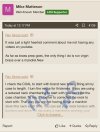No. I'll go weigh them now. From my experience Lapua is slightly thinner than federal and needs a little more powder to hit the same pressure. So I just went on past experience.
I havent compared Lapua and Hornady cases for .338 Lapua.
I found vast differences in the volumes of water or water weight each would hold.
Lapua held 114 grains h20 or so and Hornady only 107.
I say vast difference because
these volume differences are huge on velocity all other variables held constant.
For example my load on .338 LM using 96 gr N568 w 250 gr scenar is 2860 using Lapua brass w vol 114.9
Plug in Hornady at 107 in QL and you will see velocity is now 2979.
Thats 119 fps gain in velocity
just changing brass.
Check the water weights of the 2 brands of brass. I bet they are quiet different. Just a small diff in volume for the explosion, makes a lot more diff in pressure and muzzle velocity than you may appreciate.
And as we all know, bullet exit timing as regards harmonics has everything to do with group size and OCW. You need to redevelop your load using fire formed brass, different powder weight, and bullet seating.
Knowing the average water weight diff between these pieces of brass say on at least 5 to 10 pieces each will tell you a lot.
Chrono info on both will also tell you what velocity you need to try for on the new load.
Try again. Dont give up.
But your brass volumes are I bet very different.
I bet Hornady is smaller volume, higher pressure, higher velocity and you lost your node with much slower press and velocity w Lapua.
If so, you will need more powder w Lapua loads to get back to node.

